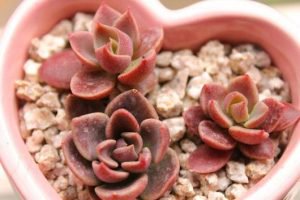Succulent plants-the shape, habits and conservation priorities of the Ice Age! Cultivation and growth environment
Succulent plants-the shape, habits and conservation priorities of the Ice Age!
English name: ice Age
Another name: ice Age
Latin scientific name: Echeveria Cimette
Families and genera: crassulaceae
Distribution of origin: South Africa
The Ice Age, a succulent plant, belongs to the hybrid of Flower Moon Night and Dongyun system, which is very close to Christmas Dongyun. There are two kinds of succulent plants in the Ice Age, and flower lovers need to analyze them carefully.
Ice Age Sedum family is a succulent plant, there is another succulent plant also known as the Ice Age, Latin name Echeveria Ice Age, the current Ice Age Echeveria Cimette, this variety is not very popular in China, the number is relatively rare. The characteristics of the red margin make it inherit the characteristics of the flower and moon night, the leaves are closely connected, it is difficult to pick leaves, the leaves are waxy, which is the remarkable feature of the winter cloud system.
In Japan and South Korea, the Latin name of wax peony is mistakenly named Echeveria nuda. In fact, Echeveria nuda is another native succulent plant of the genus Clematis, while wax peony is a horticultural variety whose parent is crossed from Echeveria agavoides (Dongyun primitive species) x Sedum cuspidatum, so it is directly labeled as Echeveria agavoides x Sedum cuspidatum in Europe (you can see the rigor of Europeans)
Main points of cultivation:
Very strong varieties need sufficient sunlight and careful irrigation to keep the plant compact and have large taproots, so watering should be grasped, excessive watering can easily cause root cracking or decay, ensure good ventilation and heat dissipation, in winter or at night, the temperature had better not be less than 10 ℃, in dry conditions, can be cold-resistant for a short time-4 ℃.
Ice Age breeding:
The planting of the Ice Age is usually seed reproduction or grafting. It is not easy to survive in other ways. The above is about the shape, habits and conservation priorities of the ice age of succulent plants. If you want to know more about how the ice age was raised, you are welcome to post it later.
- Prev

Growth habits and main distribution of succulent plants-the morphology, habits and conservation priorities of birds of paradise!
Succulent plants-the shape, habits and conservation priorities of birds of paradise! English name: bird of paradise alias: rolling leaves fall to the ground to take root, Latin name of bird of paradise: Kalanchoe beauverdii plant genus: crassulaceae, cauliflower genus distribution: Mexican succulent plant bird of paradise
- Next

Succulent plants-due to the shape, habits and conservation priorities of local cards! Cultivation and growth environment
Succulent plants-due to the shape, habits and conservation priorities of local cards! English name: Indica alias: Moxin Latin name: Sinocrassla indca family genus: sedum family distribution: South Africa Indica, a perennial succulent plant also known as Moxin
Related
- Fuxing push coffee new agricultural production and marketing class: lack of small-scale processing plants
- Jujube rice field leisure farm deep ploughing Yilan for five years to create a space for organic food and play
- Nongyu Farm-A trial of organic papaya for brave women with advanced technology
- Four points for attention in the prevention and control of diseases and insect pests of edible fungi
- How to add nutrient solution to Edible Fungi
- Is there any good way to control edible fungus mites?
- Open Inoculation Technology of Edible Fungi
- Is there any clever way to use fertilizer for edible fungus in winter?
- What agents are used to kill the pathogens of edible fungi in the mushroom shed?
- Rapid drying of Edible Fungi

